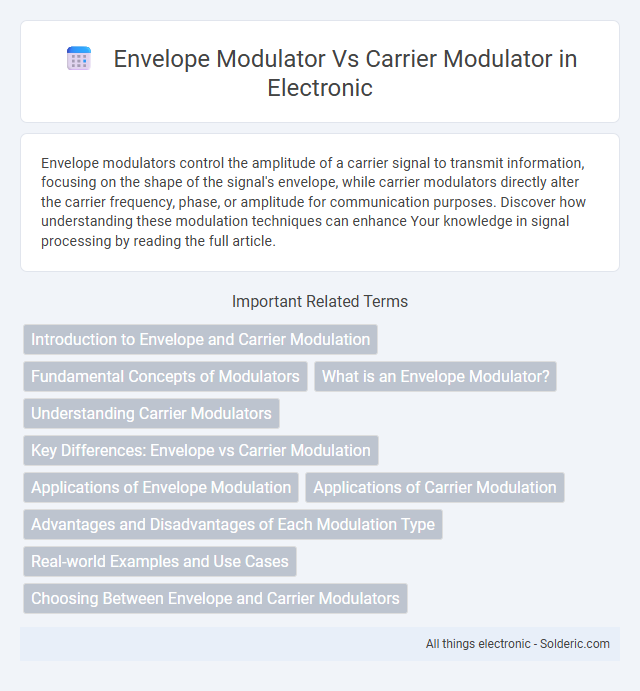Envelope modulators control the amplitude of a carrier signal to transmit information, focusing on the shape of the signal's envelope, while carrier modulators directly alter the carrier frequency, phase, or amplitude for communication purposes. Discover how understanding these modulation techniques can enhance Your knowledge in signal processing by reading the full article.
Comparison Table
| Feature | Envelope Modulator | Carrier Modulator |
|---|---|---|
| Function | Modulates the amplitude envelope of the signal | Modulates the carrier waveform directly |
| Application | Amplitude modulation (AM), audio synthesis | Frequency modulation (FM), phase modulation (PM) |
| Control Signal | Envelope generator output (e.g., ADSR) | Oscillator or carrier waveform |
| Output Characteristics | Changes signal amplitude over time | Changes frequency or phase of carrier signal |
| Complexity | Generally simpler, focused on amplitude shaping | More complex, involves modulation of carrier properties |
| Examples | AM radio, synthesizer volume control | FM radio, phase-locked loops |
Introduction to Envelope and Carrier Modulation
Envelope modulation involves varying the amplitude of a high-frequency carrier wave in accordance with the instantaneous amplitude of the input signal, effectively shaping the carrier's envelope to represent the original information. Carrier modulation, on the other hand, refers to altering one or more properties--amplitude, frequency, or phase--of the carrier wave itself to encode the input signal, serving as the fundamental process in communication systems. Understanding the distinction between modulating the envelope versus the carrier is essential for optimizing signal transmission and minimizing distortion in analog and digital communications.
Fundamental Concepts of Modulators
Envelope modulators vary the amplitude of the carrier signal according to the information signal's amplitude, creating a modulated waveform that carries the original message. Carrier modulators generate a high-frequency carrier wave, which is combined with the input signal through techniques like amplitude, frequency, or phase modulation to encode the information. Understanding these fundamental concepts helps you select the appropriate modulator for efficient signal transmission in communication systems.
What is an Envelope Modulator?
An Envelope Modulator shapes the amplitude contour of a carrier signal to match the input audio's dynamics, preserving the natural tonal characteristics of the sound. Unlike a carrier modulator that directly modifies the carrier frequency or phase, the envelope modulator emphasizes amplitude variation over time. You benefit from greater control over signal intensity, making envelope modulation ideal for applications like dynamic range compression and expressive audio synthesis.
Understanding Carrier Modulators
Carrier modulators play a crucial role in communication systems by varying a high-frequency carrier signal to transmit information efficiently. Unlike envelope modulators that shape the amplitude envelope of a signal, carrier modulators directly alter properties such as amplitude, frequency, or phase of the carrier wave for optimal signal transmission. Understanding carrier modulators helps you optimize modulation techniques for clearer, more reliable communication channels.
Key Differences: Envelope vs Carrier Modulation
Envelope modulation varies the amplitude of the carrier signal in direct proportion to the instantaneous amplitude of the message signal, enabling efficient transmission of information through amplitude changes. Carrier modulation involves altering one or more properties of a high-frequency carrier wave, such as amplitude, frequency, or phase, to encode the baseband message signal. The key difference lies in envelope modulation specifically manipulating the carrier's amplitude envelope, while carrier modulation encompasses a broader range of techniques affecting multiple carrier parameters for signal transmission.
Applications of Envelope Modulation
Envelope modulation plays a crucial role in amplitude modulation (AM) systems, where it shapes the signal's amplitude to carry information efficiently. It is widely applied in broadcasting, telecommunications, and radar systems to transmit voice, music, and data signals. The precise control of the envelope allows for better signal integrity and reduced distortion, enhancing communication clarity.
Applications of Carrier Modulation
Carrier modulation is extensively used in radio frequency transmission systems, including amplitude, frequency, and phase modulation for broadcasting and communication signals. Your ability to transmit data over long distances efficiently relies on carrier modulation techniques in applications such as satellite communication, television broadcasting, and mobile networks. These methods enable precise control of signal frequency and phase, optimizing bandwidth utilization and signal integrity.
Advantages and Disadvantages of Each Modulation Type
Envelope modulation offers simplicity and efficient use of bandwidth, making it ideal for amplitude modulation in analog communication systems, but it can be susceptible to noise and signal distortion, affecting signal quality. Carrier modulation provides better noise immunity and enables higher data rates through techniques like frequency or phase modulation, though it requires more complex transmitter and receiver designs, increasing overall system cost. Each modulation type balances trade-offs between complexity, noise resilience, and spectral efficiency depending on application requirements.
Real-world Examples and Use Cases
Envelope modulators are essential in audio synthesis and AM radio transmission, where they shape the amplitude contour of sound waves or radio signals to convey information efficiently. Carrier modulators, commonly used in frequency modulation (FM) and phase modulation (PM) systems, manipulate the carrier signal's frequency or phase to improve signal robustness and minimize noise interference. Your choice between envelope and carrier modulation depends on the desired application, such as dynamic sound design or resilient communication channels in wireless networks.
Choosing Between Envelope and Carrier Modulators
Choosing between envelope modulators and carrier modulators depends on the application's need for signal clarity and control. Envelope modulators excel in preserving the amplitude variations of the original signal, making them ideal for audio and AM radio transmissions. Carrier modulators provide precise frequency control, which is essential in FM and digital communication systems for maintaining signal integrity.
Envelope modulator vs carrier modulator Infographic

 solderic.com
solderic.com